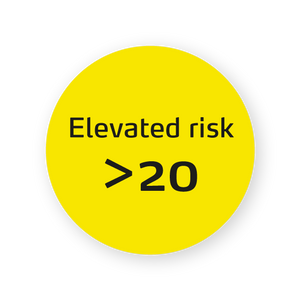CADScor® System: Overview
An advanced acoustic-based diagnostic aid to easily and quickly Risk Stratify significant coronary artery disease at point of care.*
Use CADScor® System to Determine if Chest Pain is Related to the Heart*
CADScor®System is a point-of-care diagnostic aid that uses highly sensitive acoustics and advanced computational processing to analyze the patient’s coronary blood flow. The system calculates a patient-specific CAD-score, and couples it with risk factors to rapidly indicate the patient’s risk of significant coronary stenosis for immediate risk stratification, prior to potential secondary evaluation.2 CADScor®System has been used in over 47,000 patient assessments3 and has CE-marking and FDA De Novo clearance.
CADScor System Uses Ultra-Sensitive Acoustics and Advanced Computational Processing to Rapidly Risk Stratify Coronary Artery Disease
Non-invasive and radiation free assessment with actionable results
Allow for immediate risk stratification prior to potential secondary evaluation
An Individual CAD-score Indicates Low or Elevated Significant CAD Risk in Patients
The CAD-score is based on a phonocardiographic assessment, Advanced Computational Processing powered calculations and risk factors.¹

Low Risk
40% of patients are identified as low risk4 by their CAD-score helping to streamline patient workflows. Seek alternative diagnosis for symptoms.

Elevated Risk
Patient deemed elevated risk of significant CAD by their CAD-score. Refer for further followup.

CADScor® System Research, Development and Clinical Studies
CADScor® System is based on 15+ years of R&D, covered by 45 patents, approved in Europe with CE-marking and has received FDA De Novo clearance as a diagnostic aid for symptomatic patients with suspected CAD. Multiple clinical studies with over 6,000 patients studied have been published to demonstrate CADScor® System’s performance.
Physicians’ Experiences Using CADScor® System

By submitting your information, you confirm you would like to be contacted by Acarix. Read our privacy notice here , if you want to know more about how we treat and protect your personal data.
Schedule a Demo of CADScor® System
Schedule a free demo of CADScor System and learn how to quickly and easily Risk Stratify significant CAD in symptomatic patients at point of care.*
- Winther S, et al. Heart 2018;104:928–935 (Dan-NICAD I)
- User manual US-FDA v.12.Y, prevalence 10,7%
- Based on commercial patch use since 2017
- Bjerking LH et al.Eur Heart J. Published online September 1, 2024
*Risk Stratify with at least 96% confidence (NPV)
Important Safety
Information
Risk of damage to the CADScor®System
Do not touch the charge-point terminals on the CADScor®System, due to risk of permanent damage to the electronics inside by electrostatic discharge. Do not drop or exert excessive force to the CADScor®System since this may damage the CADScor®System permanently. Do not expose the CADScor®System to liquids (water, oils, detergents or similar) or dust, since this may damage the CADScor®System permanently. The CADScor®System cannot be heator radiation sterilized, or machine washed/cleaned, since this may damage the CADScor®System permanently. Do not modify the CADScor®System or use or repair a defect CADScor®System, due to risk of malfunctioning. The CADScor®System must only be serviced by qualified Acarix personnel.
Risk of incorrect CAD-score
Incorrect placement of the CADScor® Sensor, outside patient IC4-L, may result in an incorrect CAD-score. Inform patients who have CAD-score ≤20 to seek medical attention if symptoms persist or worsen after initial evaluation”, due to the risk of a false negative CADScor result. The CAD-scores from patients in the 30-39-year group are currently outside the intended patient population. A warning triangle indicates the higher uncertainty of their CAD-score.
Precautions
Precautions are alerts to reduce potentially hazardous situations or risks of nonserious injury or reduced effectiveness from use of the CADScor®System.
Patient and user risk warnings
Do not use the CADScor®System without the necessary qualifications, and only after instruction and having read and understood this User-Manual, including, symbols, contra-indications, warnings and precautions, due to risk of death or serious injury. Do not use the CADScor®System on patients with implanted electronics like ICD, Pacemakers, heart-pumps closer than 50 cm to similar active electronic support equipment, due to risk of equipment failure from CADScor®System electromagnetic RFID impulse. Do not attempt to re-use a CADScor®Patch. The patch is single use only for hygienic reasons, to prevent possible cross contamination/infection between patients. The CADScor®System and patches are MRI-unsafe and should not be operated or placed in a Magnetic Resonance Imaging (MRI-) room, due to risk of skin burns and/or magnetic attraction and impact. Never use other power adaptor than supplied with the CADScor®System, due to risk of electrical shock.
Warnings
Warnings are alerts described to alert and reduce the risk of death or serious injury from use of the CADScor®System. Warnings and precautions are labelled with a warning triangle and also refers to the relevant section in the User Manual.
Indications for use
The CADScor®System is indicated for use as a diagnostic aid in symptomatic patients suspected of stable Coronary Artery Disease/Chronic Coronary Syndrome. Symptoms of CAD/CCS may manifest as* Typical angina symptoms; (all three below) • Sub-sternal chest discomfort of characteristic quality and duration • Provoked by exertion or emotional stress; • Relieved by rest and/or nitrates within minutes. Atypical angina symptoms; (Two of the above) Non-anginal chest pain; Lacks or meets only one or none of the above characteristics. Dyspnea/breathlessness *as defined by ESC Guidelines 2019 &NICE UK Guidelines CG95, 2019
Intended Use
The intended use of the CADScor®System is to record heart sounds, i.e. murmurs and vibration for calculation of a patient specific score, the CAD-score, indicating the risk of coronary stenosis, as an aid in cardiac analysis and diagnosis.
The intended use of the CADScor®System is to record heart sounds, i.e. murmurs and vibration for calculation of a patient specific score, the CAD-score, indicating the risk of coronary stenosis, as an aid in cardiac analysis and diagnosis.
The CADScor®System is indicated for use as a diagnostic aid in symptomatic patients suspected of stable Coronary Artery Disease/Chronic Coronary Syndrome.
Symptoms of CAD/CCS may manifest as*
Typical angina symptoms;
(all three below)
• Sub-sternal chest discomfort of characteristic quality and duration
• Provoked by exertion or emotional stress;
• Relieved by rest and/or nitrates within minutes.
Atypical angina symptoms;
(Two of the above)
Non-anginal chest pain;
Lacks or meets only one or none of the above characteristics.
Dyspnea/breathlessness
*as defined by ESC Guidelines 2019 &NICE UK Guidelines CG95, 2019
Warnings are alerts described to alert and reduce the risk of death or serious injury from use of the CADScor®System.
Warnings and precautions are labelled with a warning triangle and also refers to the relevant section in the User Manual.
Do not use the CADScor®System without the necessary qualifications, and only after instruction and having read and understood this User-Manual, including, symbols, contra-indications, warnings and precautions, due to risk of death or serious injury.
Do not use the CADScor®System on patients with implanted electronics like ICD, Pacemakers, heart-pumps closer than 50 cm to similar active electronic support equipment, due to risk of equipment failure from CADScor®System electromagnetic RFID impulse.
Do not attempt to re-use a CADScor®Patch. The patch is single use only for hygienic reasons, to prevent possible cross contamination/infection between patients.
The CADScor®System and patches are MRI-unsafe and should not be operated or placed in a Magnetic Resonance Imaging (MRI-) room, due to risk of skin burns and/or magnetic attraction and impact.
Never use other power adaptor than supplied with the CADScor®System, due to risk of electrical shock.
Precautions are alerts to reduce potentially hazardous situations or risks of nonserious injury or reduced effectiveness from use of the CADScor®System.
Incorrect placement of the CADScor® Sensor, outside patient IC4-L, may result in an incorrect CAD-score.
Inform patients who have CAD-score ≤20 to seek medical attention if symptoms persist or worsen after initial evaluation”, due to the risk of a false negative CADScor result.
The CAD-scores from patients in the 30-39-year group are currently outside the intended patient population. A warning triangle indicates the higher uncertainty of their CAD-score.
Do not touch the charge-point terminals on the CADScor®System, due to risk of permanent damage to the electronics inside by electrostatic discharge.
Do not drop or exert excessive force to the CADScor®System since this may
damage the CADScor®System permanently.
Do not expose the CADScor®System to liquids (water, oils, detergents or similar) or dust, since this may damage the CADScor®System permanently.
The CADScor®System cannot be heator radiation sterilized, or machine washed/cleaned, since this may damage the CADScor®System permanently.
Do not modify the CADScor®System or use or repair a defect CADScor®System, due to risk of malfunctioning. The CADScor®System must only be serviced by qualified Acarix personnel.